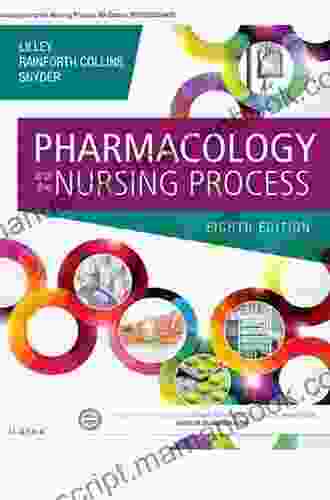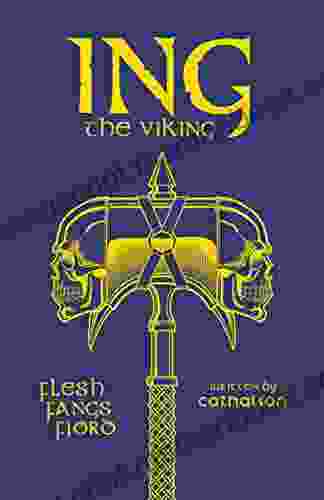Pharmacology and the Nursing Process: A Comprehensive Guide for Nurses

Pharmacology is the study of drugs and their effects on the human body. It is an essential part of the nursing process, as nurses are responsible for administering medications to patients and monitoring their response.
This article provides a comprehensive overview of pharmacology for nurses, covering topics such as drug classification, pharmacokinetics, and pharmacodynamics.
Drugs are classified into different groups based on their chemical structure, mechanism of action, and therapeutic use. The main drug classifications include:
4.6 out of 5
| Language | : | English |
| File size | : | 27196 KB |
| Text-to-Speech | : | Enabled |
| Screen Reader | : | Supported |
| Enhanced typesetting | : | Enabled |
| Print length | : | 3743 pages |
- Antibiotics are used to treat bacterial infections.
- Antifungals are used to treat fungal infections.
- Antivirals are used to treat viral infections.
- Analgesics are used to relieve pain.
- Anti-inflammatories are used to reduce inflammation.
- Antineoplastics are used to treat cancer.
- Cardiovascular drugs are used to treat heart and blood vessel conditions.
- Central nervous system drugs are used to treat conditions of the brain and spinal cord.
- Gastrointestinal drugs are used to treat conditions of the stomach and intestines.
- Hormones are used to replace or supplement natural hormones in the body.
Pharmacokinetics is the study of how drugs are absorbed, distributed, metabolized, and excreted from the body. These processes determine the concentration of a drug in the body and its duration of action.
Absorption is the process by which a drug enters the body. Drugs can be absorbed through the skin, the lungs, the gastrointestinal tract, or the mucous membranes. The rate of absorption depends on the drug's solubility, molecular weight, and ionization state.
Distribution is the process by which a drug is distributed to different tissues and organs in the body. Drugs can be distributed through the bloodstream, the lymphatic system, or by diffusion. The distribution of a drug depends on its solubility, protein binding, and tissue affinity.
Metabolism is the process by which a drug is broken down into smaller molecules. Drugs are metabolized in the liver and other organs. The rate of metabolism depends on the drug's chemical structure and the activity of the enzymes that metabolize it.
Excretion is the process by which a drug is eliminated from the body. Drugs are excreted in the urine, feces, or sweat. The rate of excretion depends on the drug's molecular weight, polarity, and solubility.
Pharmacodynamics is the study of how drugs interact with the body to produce their effects. Drugs can interact with receptors, enzymes, or other molecules in the body. The interaction between a drug and its target molecule determines the drug's effect.
Receptors are proteins that bind to drugs and other molecules. When a drug binds to a receptor, it can trigger a cascade of events that leads to the drug's effect. Receptors are located throughout the body, including on the surface of cells, in the cytoplasm, and in the nucleus.
Enzymes are proteins that catalyze chemical reactions in the body. Drugs can inhibit or activate enzymes, which can alter the rate of a chemical reaction and the production of certain molecules.
Drugs can also interact with other molecules in the body, such as hormones, neurotransmitters, and nucleic acids. These interactions can alter the function of these molecules and produce a wide range of effects.
The nursing process is a systematic approach to providing care to patients. The nursing process includes five steps:
- Assessment
- Diagnosis
- Planning
- Implementation
- Evaluation
Pharmacology is an essential part of the nursing process. Nurses use their knowledge of pharmacology to assess patients' medication needs, develop plans of care, implement medication regimens, and evaluate patients' response to medications.
During the assessment phase of the nursing process, nurses collect data about the patient's medication history, current medications, and any allergies. Nurses also assess the patient's physical and mental status, as well as their knowledge of their medications.
Based on the data collected during the assessment phase, nurses develop nursing diagnoses. Nursing diagnoses are statements that describe the patient's health problems and the related factors.
During the planning phase of the nursing process, nurses develop a plan of care to address the patient's nursing diagnoses. The plan of care may include medication regimens, teaching plans, and other interventions.
During the implementation phase of the nursing process, nurses implement the plan of care. This may include administering medications, teaching patients about their medications, and monitoring patients' response to medications.
During the evaluation phase of the nursing process, nurses evaluate the patient's response to the plan of care. This may include assessing the patient's symptoms, conducting physical examinations, and reviewing laboratory tests. Based on the evaluation, nurses may revise the plan of care as needed.
Pharmacology is an essential part of the nursing process. Nurses use their knowledge of pharmacology to assess patients' medication needs, develop plans of care, implement medication regimens, and evaluate patients' response to medications. By understanding the principles of pharmacology and the nursing process, nurses can provide safe and effective care to their patients.
4.6 out of 5
| Language | : | English |
| File size | : | 27196 KB |
| Text-to-Speech | : | Enabled |
| Screen Reader | : | Supported |
| Enhanced typesetting | : | Enabled |
| Print length | : | 3743 pages |
Do you want to contribute by writing guest posts on this blog?
Please contact us and send us a resume of previous articles that you have written.
 Top Book
Top Book Novel
Novel Fiction
Fiction Nonfiction
Nonfiction Literature
Literature Paperback
Paperback Hardcover
Hardcover E-book
E-book Audiobook
Audiobook Bestseller
Bestseller Classic
Classic Mystery
Mystery Thriller
Thriller Romance
Romance Fantasy
Fantasy Science Fiction
Science Fiction Biography
Biography Memoir
Memoir Autobiography
Autobiography Poetry
Poetry Drama
Drama Historical Fiction
Historical Fiction Self-help
Self-help Young Adult
Young Adult Childrens Books
Childrens Books Graphic Novel
Graphic Novel Anthology
Anthology Series
Series Encyclopedia
Encyclopedia Reference
Reference Guidebook
Guidebook Textbook
Textbook Workbook
Workbook Journal
Journal Diary
Diary Manuscript
Manuscript Folio
Folio Pulp Fiction
Pulp Fiction Short Stories
Short Stories Fairy Tales
Fairy Tales Fables
Fables Mythology
Mythology Philosophy
Philosophy Religion
Religion Spirituality
Spirituality Essays
Essays Critique
Critique Commentary
Commentary Glossary
Glossary Bibliography
Bibliography Index
Index Table of Contents
Table of Contents Preface
Preface Introduction
Introduction Foreword
Foreword Afterword
Afterword Appendices
Appendices Annotations
Annotations Footnotes
Footnotes Epilogue
Epilogue Prologue
Prologue Erika Pitstick
Erika Pitstick Alana Ash
Alana Ash Albert Einstein
Albert Einstein Peter Worley
Peter Worley R L Walker
R L Walker Shawn Wickens
Shawn Wickens Shoshana Zuboff
Shoshana Zuboff Maria Wheeler
Maria Wheeler David Kessler
David Kessler David Wright
David Wright James Bacchus
James Bacchus Leslie Atkins Elliott
Leslie Atkins Elliott Alison L Blumenfeld
Alison L Blumenfeld Brian Alikhani
Brian Alikhani Anatole Kaletsky
Anatole Kaletsky Shawn Raiford
Shawn Raiford Melissa Palmer
Melissa Palmer L T Ryan
L T Ryan Bradford Tuckfield
Bradford Tuckfield Jon Edgell
Jon Edgell
Light bulbAdvertise smarter! Our strategic ad space ensures maximum exposure. Reserve your spot today!

 Jacob FosterUnveiling the Secrets of The Ninth Step: A Captivating Journey in the John...
Jacob FosterUnveiling the Secrets of The Ninth Step: A Captivating Journey in the John... Derek CookFollow ·7.9k
Derek CookFollow ·7.9k Jeremy CookFollow ·18.6k
Jeremy CookFollow ·18.6k Alvin BellFollow ·2.5k
Alvin BellFollow ·2.5k Mike HayesFollow ·3.1k
Mike HayesFollow ·3.1k Harvey HughesFollow ·2.1k
Harvey HughesFollow ·2.1k J.D. SalingerFollow ·3.8k
J.D. SalingerFollow ·3.8k Neal WardFollow ·2.4k
Neal WardFollow ·2.4k Vincent MitchellFollow ·5.7k
Vincent MitchellFollow ·5.7k

 Jaylen Mitchell
Jaylen MitchellPretime Piano Jazz Blues Primer Level: A Comprehensive...
The Pretime Piano...

 Mark Twain
Mark TwainSurviving and Thriving with the Self-Absorbed: A...
Interacting with self-absorbed...

 John Keats
John KeatsTo Love Is To Surrender: A Deep Dive into the...
Surrender is one of the most enigmatic and...

 Steven Hayes
Steven HayesRich Murphy: A Visionary Engineer Shaping the Future of...
In the annals of space...

 Neil Parker
Neil ParkerProper Love: Navigating the Hardships of the Heart
Love is a beautiful emotion that can bring...
4.6 out of 5
| Language | : | English |
| File size | : | 27196 KB |
| Text-to-Speech | : | Enabled |
| Screen Reader | : | Supported |
| Enhanced typesetting | : | Enabled |
| Print length | : | 3743 pages |












